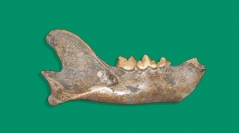

 Comptes Rendus Palevol
21 (31) - Pages 707-720
Comptes Rendus Palevol
21 (31) - Pages 707-720Felids are the top predators in the environments they inhabit. They entered South America at the Pliocene-Pleistocene boundary, but their fossil record in Uruguay, although informative, is scarce. In the present contribution, three new materials (two hemimandibles and an isolated first lower molar) assigned to Panthera onca (Linnaeus, 1758) are described. This material came from Quaternary sediments (Sopas, Dolores, and Libertad Formations) from several localities in Uruguay. Based on this material, different aspects of the paleobiology and paleoecology of jaguars are discussed. Remains of these felids were previously listed but never described; thus, the material analyzed here is the first fossil records reliably determined for P. onca in Uruguay. These felids would have shared an ecological niche with other large carnivores during the late Pleistocene in Uruguay, such as saber-toothed cats (Smilodon populator Lund, 1842; S. fatalis Leidy, 1868), Puma concolor Linnaeus, 1771, and short face bears Arctotherium Burmeister, 1879; and they would have fed upon medium-sized herbivores, principally in vegetated environments.
Felidae, Panthera onca, Quaternary, Uruguay